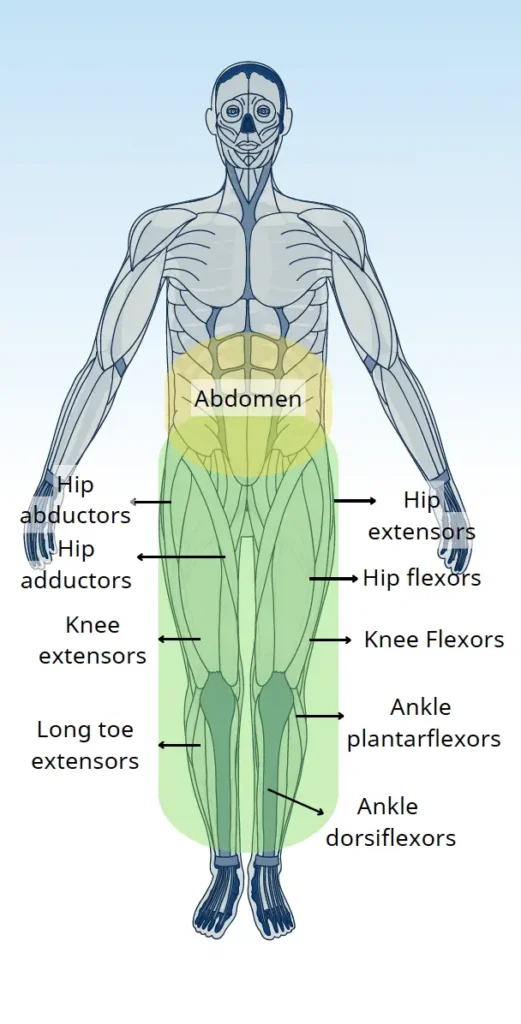Vuk
- Spinal Cord Injury (SCI),
- T12, Complete
Epidural Stimulation

| Treatment received | Implantation site | Number of devices | Duration of stay |
|---|---|---|---|
| Epidural Stimulation | Lumbar spinal cord | 1 | 46 days |
| Post-surgical care | Total sessions | Sessions per week | Time (Hr.) per session |
|---|---|---|---|
| Mapping | 128 | 20 | 1 |
| Physical therapy | 28 | 5 | 1 |
| Total sessions of rehabilitation | 156 |

| Muscle improvement | Before ES Surgery | At discharge (35 days after ES surgery) |
|---|---|---|
| Hip flexors | 0 | 2+ |
| Hip extensors | 0 | 2+ |
| Hip abductors | 0 | 2 |
| Hip adductors | 0 | 2 |
| Knee extensors | 0 | 4 |
| Knee flexors | 0 | 4 |
| Ankle dorsiflexors | 0 | 2 |
| Ankle plantarflexors | 0 | 4 |
| Long toe extensors | 0 | 0 |
| Abilities & Symptoms | Before ES Surgery | At Discharge (35 days after ES Surgery) |
|---|---|---|
| Standing with support | Not possible | Possible |
| Stepping with support (for more than 10 meters) | Not possible | Possible |
| Standing Balance | Absent * | Fair * |
| Sitting Balance | Normal * | Good * |
| Motor Coordination (while walking) | Poor * | Good * |
| Sit to Stand | Not applicable (due to bone density) | Not applicable (due to bone density) |
| Ability to transfer | Assistant required | Less assistant required |
| Ability to use abdominal muscles during bowel program | Not possible | No change |
| Stamina & Fatigue | Poor * | Endurance increased |
| Spasticity | Absent | Moderate spasticity (Increased to activate muscle tone) |
| Abilities & Symptoms | Before ES Surgery | At Discharge (35 days after ES Surgery) |
|---|---|---|
| Neuropathic pain | Absent | No change |
| Temperature sensations | No sensation (below the level of injury) | No change |
| Proprioception | Absent | No change |
| Bladder sensation | No sensation | No change |
| Bowel sensation | No sensation | No change |
| Abilities & Symptoms | Before ES Surgery | At Discharge (35 days after ES Surgery) |
|---|---|---|
| Sweating ability | No sweat * | No change |
| Temterature regulation | Normal | Normal |
| Blood pressure regulation | Stable | Stable |
Vuk reported significant improvements in his motor function. He regained hip flexors, extensors, adductors, abductors, knee extensors and flexors as well as movements distally. He was able to stand and walk with support which was not possible before.
No change in his sensory function at the time of discharge.
No change in his autonomic function at the time of discharge. He had stable blood pressure levels at the time of surgery.
His sitting function improved significantly at the time of discharge.
He was able to stand and stay upright for extended periods of time.
Vuk sustained a traumatic spinal cord injury at the T12 level as a result of a fall which rendered him to be paralyzed in his lower limbs. He also lost control of his bowel and bladder functions. He had been receiving standard physiotherapy since the injury which helped him maintain muscle mass and tone. However, there was no recovery of the voluntary motor function in his lower limbs, and he was paralyzed.
After the Epidural Stimulation surgery, Vuk had a break of 2 days and then he started with a comprehensive rehab program. Vuk encountered difficulties during the mapping sessions due to frequent changes in the programs tailored for specific activities. Consequently, we offered him to extend his stay by 6 days at no additional cost. Ultimately establishing stable programs to facilitate Vuk’s ongoing therapy upon his return to Serbia.
He reported improvements in his muscle function and control, which slowly but gradually improved to an extent where he was able to walk again. He also reported improvements in his standing ability. He did not report any complications related to the treatment. He was discharged with specific treatment plans to follow in Serbia to continue the recovery process.
We use cookies on our website to give you the most relevant experience by remembering your preferences and repeat visits. By clicking “Accept All”, you consent to the use of ALL the cookies. However, you may visit "Cookie Settings" to provide a controlled consent.